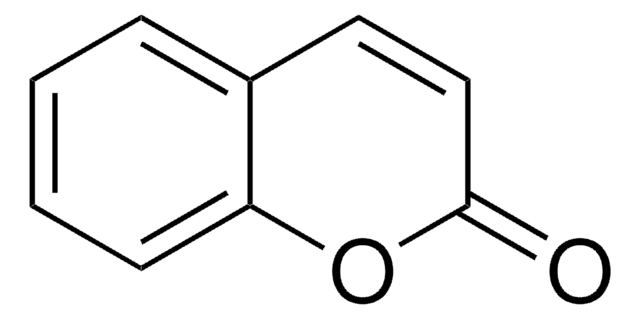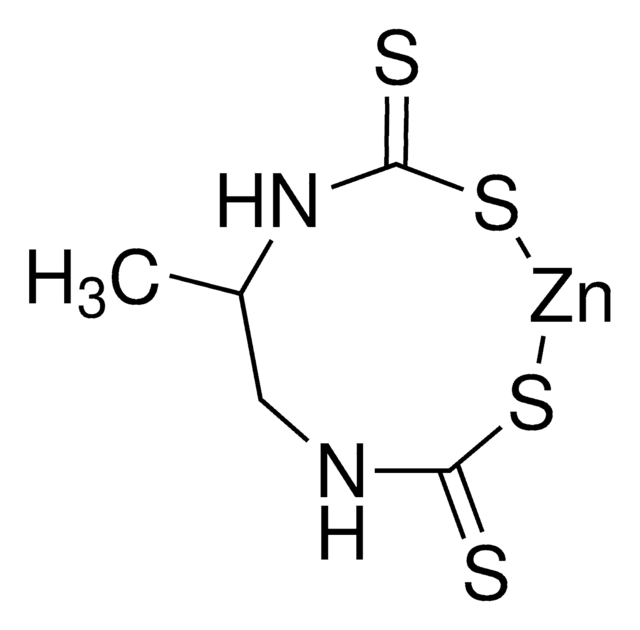추천 제품
Grade
analytical standard
Quality Level
제품 라인
PESTANAL®
유통기한
limited shelf life, expiry date on the label
기술
HPLC: suitable
gas chromatography (GC): suitable
응용 분야
agriculture
environmental
형식
neat
SMILES string
CCOC(=O)NCCOc1ccc(Oc2ccccc2)cc1
InChI
1S/C17H19NO4/c1-2-20-17(19)18-12-13-21-14-8-10-16(11-9-14)22-15-6-4-3-5-7-15/h3-11H,2,12-13H2,1H3,(H,18,19)
InChI key
HJUFTIJOISQSKQ-UHFFFAOYSA-N
유사한 제품을 찾으십니까? 방문 제품 비교 안내
일반 설명
Fenoxycarb is a neurotoxic carbamate, insect growth regulator or public health insecticide, which can exhibit potent insect juvenile hormone-mimic activity, which causes disturbance in the development, reproduction and behaviour of insects. It can be used to control a wide variety of insect pests, basically in agriculture, forestry, and stored products.
애플리케이션
Refer to the product′s Certificate of Analysis for more information on a suitable instrument technique. Contact Technical Service for further support.
법적 정보
PESTANAL is a registered trademark of Merck KGaA, Darmstadt, Germany
신호어
Warning
유해 및 위험 성명서
Hazard Classifications
Aquatic Acute 1 - Aquatic Chronic 1 - Carc. 2
Storage Class Code
11 - Combustible Solids
WGK
WGK 3
Flash Point (°F)
Not applicable
Flash Point (°C)
Not applicable
개인 보호 장비
Eyeshields, Gloves, type N95 (US)
가장 최신 버전 중 하나를 선택하세요:
이미 열람한 고객
Takeru Matsumoto et al.
Chemosphere, 72(3), 451-456 (2008-04-02)
It was reported that males daphnid Daphnia magna that have been induced by methyl farnesoate exposure exhibit higher tolerance to chemical compounds such as potassium dichromate and pentachlorophenol than females. Male neonates are also known to be induced by exposure
Koutaro Maeno et al.
Journal of insect physiology, 55(9), 849-854 (2009-06-10)
The mechanism underlying the phase-dependent polyphenism in hatchling body coloration was studied by testing for a possible causal relationship with egg size in the desert locust, Schistocerca gregaria. Crowd-reared (gregarious) females typically produce large, black offspring, whereas females reared in
H Jin et al.
Science advances, 5(4), eaav7569-eaav7569 (2019-04-17)
Color patterns often function as camouflage to protect insects from predators. In most swallowtail butterflies, younger larvae mimic bird droppings but change their pattern to mimic their host plants during their final molt. This pattern change is determined during the
Shigeto Oda et al.
Ecotoxicology and environmental safety, 67(3), 399-405 (2007-02-10)
Acute and reproductive toxicity tests were conducted on seven strains of Daphnia magna from six laboratories in five countries. 3,4-Dichloroaniline (DCA) and fenoxycarb were used as test chemicals. Acute toxicity tests revealed that estimated EC(50) (50% effective concentration) values for
P Palma et al.
Chemosphere, 76(3), 335-340 (2009-05-01)
The water flea Daphnia magna belongs to the cyclical parthenogenic species, which can reproduce by either parthenogenesis or sexual reproduction. Recent studies have reported the involvement of the methylfarnesoate hormone, in male sex determination of D. magna. The aim of
자사의 과학자팀은 생명 과학, 재료 과학, 화학 합성, 크로마토그래피, 분석 및 기타 많은 영역을 포함한 모든 과학 분야에 경험이 있습니다..
고객지원팀으로 연락바랍니다.












